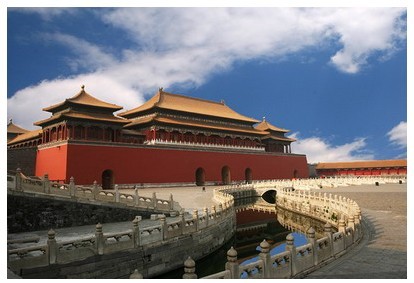The Forbidden City In Beijing
 Forbidden City, was the imperial palaces of the Ming and Qing dynasties. In early 15th century, large-scale construction involved 100, 000 artisans and one million civilians. The construction took 14 years and was finished in 1420. In the following year, the capital of the Ming Dynasty was moved from Nanjing to Beijing. Twenty-four emperors of the Ming and Qing dynasties ruled from the Forbidden City. The last dynasty fell in 1911, but Emperor Puyi still lived in the inner court. It was not until 1925that the complex was converted into a museum. Since then the palace has been opened to the public.
Forbidden City, was the imperial palaces of the Ming and Qing dynasties. In early 15th century, large-scale construction involved 100, 000 artisans and one million civilians. The construction took 14 years and was finished in 1420. In the following year, the capital of the Ming Dynasty was moved from Nanjing to Beijing. Twenty-four emperors of the Ming and Qing dynasties ruled from the Forbidden City. The last dynasty fell in 1911, but Emperor Puyi still lived in the inner court. It was not until 1925that the complex was converted into a museum. Since then the palace has been opened to the public.
Beijing is the capital of Yuan, Ming and Qing dynasties, emperor, nobles, officials, rich men and intellectuals all lived in Beijing, so many handicraft industry congregate in Beijing city. On account of the jade’s high status in Chinese culture, placed jade carving in family and gird jade ware on body were considered posted and cultural. In the Forbidden City you can see many jade carvings placed in emperor’s bedroom and office. Therefore Beijing’s jade carving industry is very flourish, extended to today.
In ancient China, from the emperor to common people all concerned a science that is Fengshui, the wind and water in English. The science mainly expounds the relationship between the location and human fortune. Even in nowadays, in China or foreign countries’ China town, when Chinese people want to built some new construction, normally invite a geomancer to research the place, if here is good, we will start constructing; if here is bad, we will placed something to ward off the evil spirits. Normally, the ways are placed small mirror above the door; placed Buddha statue face to door and placed jade carving on some special positio.
Palace Museum is located in the centre of Beijing, covering an area of 72 hectares. It is rectangular in shape, 960 metres long from north to south and 750 metres wide from east to west. There is a10-metre-high wall, encircled by a 52-metre-wide moat. In the Ming Dynasty, the timber needed for building the palace was brought mostly from Sichuan, Hunan and Guizhou provinces, while in the Qing Dynasty, it was cut from northeast China. Most of the stones were quarried from the suburban district of Fangshan and other districts. Construction of the Forbidden City brought tremendous hardship to the labouring people.



